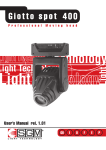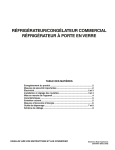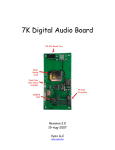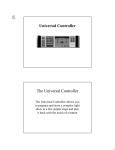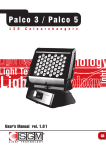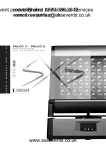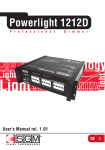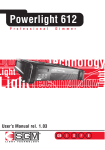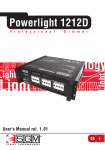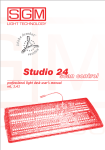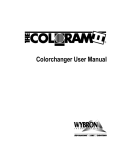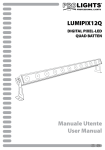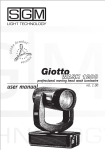Download IL-GIOTTO1200S Manual - Techni-Lux
Transcript
Giotto spot 1200 P r o f e s s i o n a l User’s Manual rel. 1.00 M o v i n g h e a d General instructions Read the instructions in this handbook carefully, as they give important information regarding safety during installation, use and maintenance. Be sure to keep this instruction manual with the fixture, in order to consult it in the future. If the fixture is sold or given to another operator, make certain he or she also receives the manual, to be able to read about its operation and follow the relative instructions. * This fixture is not intended for home use. * After having removed the packaging, check that the fixture is not damaged in any way. If in doubt, don't use it and contact an authorized SGM Technical Service Centre. * Packaging material (plastic bags, polystyrene foam, nails, etc.) must not be left within children's reach, as it can be dangerous. * This fixture must only be operated by adults. Do not allow children to tamper or play with it. * Electrical work necessary for installing the fixture must be carried out by a qualified electrician or experienced person. Never use the fixture under the following conditions: * In places subject to excessive humidity * In places subject to vibrations or bumps. * In places with a temperature of over 45°C or less than 2°C * Protect the fixture from excessive dryness or humidity (ideal conditions are between 35% and 80%). * Do not dismantle or modify the fixture.* Make certain that no inflammable liquids, water or metal objects enter the fixture. * Should any liquid be spilled on the fixture, disconnected the power supply to the fixture immediately. * In the event of serious operating problems, stop using the fixture immediately and either contact the nearest SGM sales point for a check or contact the manufacturer directly. * Do not open the fixture - there are no user serviceable parts inside. * Never try to repair the fixture yourself. Repairs by unqualified people could cause damage or faulty operation. Contact your nearest authorized service centre. • When carrying out any work, always comply scrupulously with all the norms (particularly regarding safety) currently in force in the country in which the fixture's being used. Always insist on original spare parts being fitted. General warranty conditions • The unit is guaranteed for 12 months from the date of purchase against manufacturing material defects. Breakdown caused by carelessness and improper use of the fixture is excluded. • The guarantee is no longer valid if the unit has been tampered with or repaired by unauthorized personnel. Replacement of the fixture is not foreseen by the guarantee. • External parts, knobs, switches, removable parts and lamps are excluded from the guarantee: these are covered by their manufacturers' guarantee conditions. • Transport costs and related risks are borne by the fixture's owner. The guarantee is valid to all effects only on presentation of the guarantee certificate to the manufacturer or the nearest SGM technical assistance centre. Giotto spot rel.1.00 • Always quote the unit's serial number and model when contacting your reseller for information or assistance. Protect the environment: don't throw packing material into your garbage can - return it to your SGM retailer or take it to the nearest special waste collection point. 2 index Intruduction Main features Technical Specifications 1.0 - Installation 1.1 - Locking and unlocking the mechanism 1.2 - Access to the interior 1.3 - Fitting the lamp 1.4 - Lamp alignment 1.5 - Power cable construction 1.6 - Giotto Spot's power supply 1.7 - Installing the fixture on a support structure 1.8 - Positioning the fixture 1.9 - Installing clamps 2.0 - Signal cable construction 2.1 - Construction of the DMX terminator 2.2 - RS-232 connection 3 - Microcomputer control 3.1 - Navigating in the menu 3.2 - Allocating the start channel 3.3 - Pan direction 3.31 - Limiting Pan 3.4 - Tilt direction 3.41 - Limiting tilt 3.5 - Inverting Pan/Tilt 3.6 - Lamp elapsed time meter 3.61 - Resetting the lamp's elapsed time meter 3.7 - Lamp strike counter 3.71 - Resetting the lamp's strike counter 3.8 - Fixture operating time meter 3.9 - Input signal 3.10 - Pan/Tilt resolution 3.11 - Remote control of lamp ignition 3.12 - Remote fixture reset 3.13 - Display brightness 3.14 - Display reading position 3.15 - Test functions 3.16 - Control of the acceleration of movement speed 3.17 - DMX DLY 3.18 - SLLF 3.19 - Reserved functions 4 - Giotto Spot 1200 control channels 5- Iris channel -ch5 6 - Color channel - CH67 - Gobo channel - CH7 8 - Shutter/Strobe channel - CH8 9 - Dimmer - ch 9 -24 10 - Gobo rotation - ch 1011 - Prisms - ch 11 12 - Prism Rotation - ch 12 13 - Electronic focus - ch 13 14 - Additional lenses - ch 14 15 - Color Filters - ch 15 16 - Frost - ch 16 17 - Mspeed - ch 17 18 - Lamp ignition and remote reset- ch 18 - Giotto spot rel.1.00 4 5 7 8 8 8 9 9 10 10 10 11 11 12 12 13 14 14 16 17 17 17 17 18 18 18 18 18 19 19 19 19 19 20 20 20 20 20 21 21 22 22 23 24 25 25 26 25 26 27 27 27 28 28 28 EN I D F E Appendix 3 Introduction Giotto spot rel.1.00 Giotto Spot 1200 is an innovative professional SGM moving head fixture designed and built for use in large show events, theatres, TV studios and entertainment venues in general. The result of SGM's many years' experience in mechanical and electronic design, thanks to its avant-garde performance, Giotto Spot 1200 is one of the world's top fixtures. The use of an MSR 1200SA discharge lamp and a perfect optical system in fact make it one of the best fixtures on the market today as far as power and luminosity are concerned. The lamp and electronics are powered by an electronic ballast entirely designed by the SGM Research & Development Centre which ensures flicker-free light, bright steady light beams and lower weight than fixtures with traditional ballasts. Movement precision and speed are guaranteed by stepper motors, controlled by no less than 5 microprocessors. An ingenious system allows the fixture to be automatically repositioned in the event of accidental head movement. Thanks to its truly innovative technical features, Giotto Spot 1200 is a fixture able to offer Lighting Designers excellent solutions to all their needs. Made in Italy by SGM Electronic Stampato in Gennaio 2000 Rel.1.00 4 Main features Lamp Giotto Spots use a Philips MSR 1200SA 6500°K discharge lamp, without doubt the ideal light source for this type of fixture, as it combines reliability and long life (approximately 500 ) with astonishing luminous power. Effects - Iris - Linear 0÷100% dimmer - Shutter/Strobe from 1-10 fps - can run in music sync - Electronic focus - 72 colors + effects wheel - Colorchanger with music sync and/or blackout - 4 rotary indexed gobos + 4 fixed (all interchangeable) - 24 gobo combinations obtainable by superimposing the two wheels - Gobo change with music sync and/or blackout - 2 rotary prisms with adjustable speed in both directions - 1 variable filter frost - 1 frost filter with adjustable beam - 1 3,200°K color conversion filter (full CTO) - 1 half CTO conversion filter Movement - 540° Pan (3.8 sec.) and 270° Tilt (2.4 sec.) - 8/16 bit movement resolution - Automatic repositioning in the event of accidental head movement - invertible Pan/Tilt movement - Adjustable Pan/Tilt offset - Adjustable acceleration and speed parameters Electronic Ballast Supplied as standard with every fixture - Automatic universal 90/245V 50/60Hz power supply - Flicker-free - Reduction of lamp power in the event of fixture overheating - Power Factor Correction - Automatic energy saving if the beam is blacked out - Automatic lamp re-strike Optics - High luminous efficiency optics - 4 beam angles - 9°, 12°, 15° and 18° Display/Microcomputer - Personalization of the fixture according to installations: test functions for all effects; enabling of remote lamp On/Off via DMX; enabling of fixture reset via DMX; fixture addressing; display “flip” function (rotation through 180°); dimmable display, and more: Display of data such as: lamp elapsed time and number of strikes, fixture operating time, software version supported. Control signal Giotto spot rel.1.00 Input signal DMX 512 – RS 232 Clamping system - “Fast-Lock” clamp supplied as standard - Several mounting points for clamps, enabling the fixture to be mounted on any type of truss - Connection point for safety cable EN I D F E Appendix 5 Accessories Giotto spot rel.1.00 - Light Dome for outdoor protection cod: 0202406 - Single flight case cod: 0061741 - Double flight case cod: 0061744 - Optional clamp unit cod: 0202403 6 Technical specifications LAMP: MSR 1200SA GY16 COLOR TEMPERATURE: 6500K LIGHT OUTPUT: 96000 LUMEN LIFE: 500 HOURS POWER SUPPLY: ELECTRONICS AND LAMP ARE POWERED BY A SWITCHING POWER SUPPLY. THE FIXTURE CAN OPERATE AT ANY VOLTAGE 90V AND 240V 50HZ, 60HZ. BETWEEN POWER ABSORBED: 1500W OPTICAL SYSTEM: I NTERNAL OPTICAL GROUP COMPRISING HIGH LUMINOUS EFFICIENCY POLISHED REFLECTOR AND DOUBLE CONDENSER; BEAM ANGLES: 4 9° - 12° - 15° - 18°; ELECTRONIC FOCUS. ELECTRONICS: CS0276 (INPUT SIGNAL); MOTOR DRIVER CONTROL) CS0244 + CS0245 (ELECTRONIC BALLAST); CS 0252 (IGNITOR); CS 0268 (ELECTRONICS CS0273(PAN/TILT MOTOR DRIVER CONTROL) AND- SETTING: VIA BUILT-IN MICROCOMPUTER CONTROL SIGNAL: USITT DMX 512 OR RS-232 DMX CONTROL CHANNELS: 18 CH AUTOMATIC REPOSITIONING: VIA OPTICAL SENSORS CONSTANTLY CONTROLLING PAN AND TILT POSITION AND CORRECTING IT IN THE EVENT OF THE MOVING HEAD BEING ACCIDENTALLY MOVED. COOLING: FORCED VENTILATION BY MEANS OF TWO LOW-NOISE FANS WHOSE SPEED IS ELECTRONICALLY CONTROLLED ACCORDING TO CHANGES IN TEMPERATURE IN THE FIXTURE. PROTECTION FUSES: 2X16A CF 6.3 X 32 TYPE FUSES BODY: SHEET METAL WITH POWDER PAINT FINISH AND EXTRUDED/DIE-CAST ALUMINIUM WITH POWDER PAINT FINISH. DIMENSIONS: (HXLXD) 77X53X47.5 WEIGHT: Giotto spot rel.1.00 Kg 30 SGM Elettronica reserves the right to improve or modify their products at any time without prior notice. Always consult the handbook of the unit being used to avoid errors and differences between t he actual functions and those shown in the book. EN I D F E Appendix 7 1- installation Before proceeding with fixture installation, make certain that the packing contains all the items shown in the following list and ensure that the fixture is undamaged. If in doubt, don't use the fixture and contact an authorized SGM technical assistance centre and the freight company. In fact, only the recipient can claim for any damage caused to the fixture during transport. • Giotto spot 1200 • Warranty • Instruction Manual • 1 Male XLR 5 P connector • 1 Female XLR 5 P connector • 1 Power-con connector • 2 Fast-Lock clamps KEEP THE PACKING MATERIAL. Packing material (plastic bags, polystyrene foam, nails, etc.) is potentially hazardous, so must never be left within children's reach. Use the original packing in the event of having to return the fixture to the manufacturer for repair or maintenance: it's been designed specifically to protect the fixture during transport. ck ck un lo remove lock before turning on the fixture togliere il blocco prima di accendere il proiettore un lo remove lock before turning on the fixture togliere il blocco prima di accendere il proiettore lo ck ck lo ck lo Giotto fixtures are fitted with a mechanical locking system for the moving parts. The moving head and yoke must be locked every time the fixture is transported, using the appropriate flightcase or the original packing, which have an suitable shock-proof support system. Remember to ALWAYS unlock the mechanism BEFORE switching on the fixture!!! The fixture is locked and unlocked by turning the two knobs on the yoke, following the printed indications ck 1.1- Locking and unlocking the mechanism un lo lo ck ck remove lock before turning on the fixture togliere il blocco prima di accendere il proiettore un lo remove lock before turning on the fixture togliere il blocco prima di accendere il proiettore DANGER! high temperature - avoid contact with persons and things. 1.2 - Access to the inside Giotto spot rel.1.00 Giotto fixtures have a simple mechanism for opening the moving head. To open the two covers, just turn the two locking screws shown in the illustration through 180°, then raise the cover. Any work must ALWAYS by carried out by qualified technical personnel. When work is finished, close the covers again, making certain that they are closed against the fixture body. ATTENTION: make sure that the fixture is off and the temperature of the parts can't cause burns (wait for at least 30 minutes after switching off). 8 1.3 - Lamp installation ATTENTION! This fixture is designed exclusively for use with Philips MSR 1200SA lamps. NEVER USE ANY OTHER TYPES OF LAMPS. • Disconnect the power supply before carrying out any work on the fixture. • Make certain that the fixture is off and the temperature of the components can't cause burns (wait at least 20 minutes after switching off). • Never carry out any work if the fixture doesn't have its protective covers or its lenses are damaged. Discharge lamps can explode. • Never look directly at the lamp when it's lit - discharge lamps emit UV rays which are dangerous for sight. There's an optical group in the fixture's moving head. Follow these instructions when fitting or replacing the lamp. 1. Disconnect the power supply and wear protective gloves and glasses. 2. Remove the head's top cover 3. (fig.1) Unscrew the two locking screws (A) on the aluminium support which fix the lampholder base to the optical group 4. (fig.2) Raise the aluminium support and fit the lamp in the base. Avoid touching the lamp bulb with your fingers. Should this happen, clean it before use with a soft cloth and alcohol, then clean with a dry cloth. 5. (fig.3) Tighten the screws again, making certain that the lamp wires are positioned in the appropriate slots. 6. Close the cover again. A MSR 1200SA A fig.1 fig.2 fig.3 1.4 - Lamp Alignment After each relamping, it's important to align the lamp with the optical group in order to obtain maximum uniformity and light output. 1. Fit the new lamp, close the fixture and switch it on. 2. Connect the fixture to a lighting console. 3. Point the fixture at a flat surface (if possible light coloured) at a distance of at least 3metres. 4. Set the control channels in such as way as to obtain the projection of a white beam. Then: IRIS open, DIMMER at maximum luminosity, suitable FOCUS, no GOBO or COLOR projected. 5. (Fig.4) Loosen the two fastening screws (A) and use the knobs on the sides to align the lamp horizontally. 6. (Fig.5) Use the large centre brass ferrule to align the lamp vertically with respect to the optical group. 7. The lamp is aligned correctly when a uniform beam is obtained, without any shadows or zones which are brighter than others. 8. (Fig.6) Tighten the fastening screws and close the cover again A EN fig.4 I D fig.5 F E Appendix A Giotto spot rel.1.00 A A fig.6 9 1.5-Power cable construction DANGER! ELECTRICAL SHOCK HAZARD • Electrical work necessary for installing the fixture must be carried out by a qualified electrician or an experienced person. • The fixture must be suitably earthed. Failure to comply with this automatically invalidates the guarantee. The POWER-CON type connector supplied along with the Giotto is indispensable for connecting the fixture to the power supply. The following design shows how to connect the connector to the cable, whereas the table shows the symbols normally used to indicate connections. When in doubt, consult a qualified electrician. CABLES Brown Blue Yellow/Green PIN Phase Neutral Ground TYPICAL “L” “N” US Yellow/Copper Silver Green UK Red Black Green N Conductors' cross-section Power supply Minimum cross-section 230 V 3x1,5 120 V 3x2,5 L 1.6 - Giotto Spot's power supply ATTENTION!! • Don't power the Giotto with a dimmer circuit - this could damage the electronic ballast. • Before connecting the fixture, make certain that the data on the fixture's plate correspond with those of the local main power supply. • The fixture must be connected to a cut-off circuit with the following characteristics: Cut-off circuit Power supply 230 V 120 V in 16A 32A id 0,03A 0,03A Giotto spot rel.1.00 1.7- Installing the fixture on a support structure Read the following safety information before proceeding with the installation of the fixture: • Fixture not for domestic use. • Do not install the fixture near sources of heat. • Install the fixture in a well ventilated place. • Avoid blocking air intakes and outputs. • Do not use the fixture: - In places subject to vibrations or bumps - In places with excessive humidity - In places subject to temperatures of more than 45° or less than 2°C • Protect the fixture from excessive humidity (ideal values are between 35 and l’80%). • Avoid inflammable liquids, water or metallic objects entering the fixture . • Keep any inflammable material at a distance of at least 1.5m from the fixture. • Position the fixture at least 1.5m. from the surface to be lit. • Don't lift the fixture holding it by the moving part (the head). 10 1.8 - Positioning the fixture Can be installed in any position. down enter down enter up gain up mic GIOTTO REL. 1.00 control in/out dmx moving head wash luminaire Giotto1200 fuses main power main power fuses Giotto1200 moving head wash luminaire in/out dmx control GIOTTO REL. 1.00 mic down up up down enter gain enter OK OK OK 1.9 - Fitting clamps Always use two clamps to hang the fixture. Fix the fixture to the support structure using safety chains fitted to the 2 holes on the underside of the fixture's base. Don't fix the safety chain to the handles. Remember to unlock the PAN and TILT locking system once the fixture is mounted on the support structure. safety chain socket 15° Giotto spot rel.1.00 • • • • EN I D F E Appendix 11 2.0-Construction of the signal cable Giotto 1200 has a DMX 512 input fitted with standard 5-pin XLR connectors. Screened cables in compliance with EIA RS485 specifications and the following characteristics must be used for connections: - 2 conductors plus screen - 120Ohm impedance - low capacitance - max. transmission rate 250kBaud. Cable connections: 1 5 4 3 COMMON DMXDMX+ 2 see illustration, taking care with the screen, which must be connected to Pin 1 ATTENTION: the screened parts of the cable (sleeve) must NEVER be connected to the system's earth, as this would cause faulty fixture and controller operation. Example of connection of the DMX line main power main power fuses fuses Giotto1200 Giotto1200 moving head wash luminaire moving head wash luminaire in/out dmx in/out dmx control in/out dmx control GIOTTO REL. 1.00 control GIOTTO REL. 1.00 GIOTTO REL. 1.00 mic down mic up up down enter gain enter gain enter up down down enter up down up up mic down enter main power fuses Giotto1200 moving head wash luminaire gain enter DMX linea DMX controller Pilot2000 DIMMR COLOR GOBOS SHUTT ROTGB FROST 0 0 0 0 0 0 - Termination DMX (last ap) 0 0 universal dmx controller on/off operations setup utility copy enter play extra lamp reset edit levels times preset unit step 100% 90 80 smpte rec 70 60 programming keyboard 50 page 40 store 1 - 20 30 21 - 40 20 10 0 memory obj grand master memory program chase psycho pan tilt multifunction keyboard 1 or 21 2 or 22 3 or 23 4 or 24 5 or 25 6 or 26 7 or 27 8 or 28 9 or 29 10 or 30 11 or 31 12 or 32 13 or 33 14 or 34 15 or 35 16 or 36 17 or 37 18 or 38 19 or 39 20 or 40 To avoid the risk of faulty operation, follow these indications: Maximum cable length: 500 metres Max. N° of fixtures connected: 32 Cable runs: Avoid running cables alongside power supply lines. Termination: A 120Ohm resistor between Pins 2 and 3 on the last fixture. Giotto spot rel.1.00 2.1- Construction of the DMX termination The termination avoids the risk of DMX 512 signals being reflected back along the cable when they reaches the end of the line: under certain conditions and with certain cable lengths, this could cause them to cancel the original signals. The termination is prepared by soldering a 120Ohm 1/4 W resistor between pins 2 and 3 of the 5-pin male XLR connector (see diagram). 1 5 4 12 3 2 120Ω 2.2-RS232 connection Giotto spot rel.1.00 For this connection, use good quality screened coax cable (RG58 50Ohms) to avoid problems with signal transmission and faulty fixture operation. Connectors must always be 5-pin XLRs. Refer to the diagram for wiring. EN I D F E Appendix 13 3.0 - “Control” microcomputer Giotto Spot 1200 is equipped with a microcomputer which allows to customize the fixture to suite the type of installation. In fact, it's possible to assign the start address; obtain information regarding lamp life and fixture operation time; run test programs to check correct fixture operation and customize some parameters. 3.1- Navigating in the menu E010485 - 31. When it's switched on, the fixture runs a start-up reset procedure and the display indicates if there's an input signal or not. Giotto 1.4 The 3 keys under the display are for selecting and using the various submenus which make up the main menu. 1 E010485 - 31 E010485 - 31 - UP/DOWN keys: used to scroll the various items in the menu. In the selected menu, used to change the required parameters. - ENTER key: used to access to the selected menu and, once the necessary changes have been made, is used to confirm them. 2 Giotto 1.4 Giotto spot rel.1.00 Accel 14 Menu Description Options (Default configurations are shown in bold text) Addr=xxx Range 001-487 Addressing the fixture Pmove NORM Normal control of Pan from left to right REV Control of Pan inverted - from right to left. PP_min Range 000-540 Sets Pan starting angle. Default Configuration = 000 degrees PP_max Range 000-540 Range 000-540 Sets Pan ending angle. Default Configuration = 000 degrees NORM Normal control of Tilt from up to down. REV Control of Tilt inverted, from bottom to top. TP_min Range 000-270 Range 000-270 Set Tilt starting angle. Default Configuration = 000 degrees TP_max Range 000-270 Range 000-270 Sets Tilt ending angle Default Configuration = 000 degrees ON Pan is controlled by Tilt commands and vice versa OFF Normal control of Pan and Tilt . . Tmove Swap Lmp_H Read-only menu. Records the elapsed time of the lamp. Can be reset. Lmp_st Read-only menu. Records the number of lamp strikes. Can be reset. SCN_h Read-only menu. Records total fixture operating time. SIGN DMX Signal DMX selected RS-232 Signal RS-232 selected 16 bit 8 bit Allows to select movement resolution. Default configuration = 16-bit EN Remote control of lamp ignition enabled. DS Remote control of lamp ignition disabled. EN Remote control of reset enabled. DS Remote control of reset disabled. Speed 100% - 92% 84% - 76% Possibility of slowing the maximum speed of PAN and TILT movement. Default configuration = 100% Accel Fast Optimizes speed performance. Slow Optimizes performance for the smooth movement 100-53-40-27-20-136-0 (%) Allows to regulate the brightness of the display. Default configuration=40% SMD LMP_ctr RST_ctr Inverts the reading position of the display. Used according to the position of the fixture. DsplFlip DMXdly Range 8-998 sec It's possible to decide for how many seconds the fixture's last operating status must be held when there's no DMX signal (default =20sec.). it maintains always the last condition of job independently from how much time lacks the dmx UNL ON Energy saving enabled OFF Energy saving disabled Giotto spot rel.1.00 Bright SLLF TEST Reserved Read-only menu giving information on the software version supported by the fixture. Giotto 1.4 EN I D F E Appendix 15 3.2 - Allocating the first addressed channel In order to receive the commands necessary to operate from a lighting console, each fixture has to be allocated a start address. This address normally indicates the first channel used (start channel) and can be allocated following a different criterion from that used to connect the signal line. Giotto Spot uses 18 controls channels, so during allocation, this quantity must be borne in mind to avoid possible overlapping of other fixtures' channels, which would cause problems with the perfect control of all the available functions. Should it be necessary, it's possible to allocate the same start channel to several fixtures, in this case the fixtures will all follow the same commands, but can't be controlled separately. To address fixtures correctly, proceed as follows: 1. Connect Giotto Spot to the power supply, wait until it has completed reset operations and “DMX signal” appears on the display. 2. Use the UP/DOWN keys to find the “Addr” menu 3. Press ENTER to confirm. The message on the display starts to flash. 4. Use the UP/DOWN keys to select the channel required. 5. Press ENTER to confirm. Fixture N. Giotto spot rel.1.00 1 2 3 4 5 6 7 16 Start Address 001 019 037 055 073 091 109 Fixture N. 8 9 10 11 12 13 14 Start Address 127 145 163 181 199 217 235 Fixture N. Start Address Fixture N. Start Address 15 16 17 18 19 20 21 253 271 289 307 325 343 361 22 23 24 25 26 27 28 379 397 415 433 451 469 487 3.3 - Direction of Pan movement This function allows to decide the direction in which the Giotto's moving head pans, indispensable when several fixtures are installed in order that fixtures installed opposite each other move in the same direction when they receive a command. To modify Pan movement, proceed as follows: 1. 2. 3. 4. 5. Connect the Giotto Spot to the power supply, wait till it has completed reset operations and “DMX signal” appears on the display. Use the UP/DOWN keys to find the “Pmove” menu Press ENTER to confirm. The message on the display will start to flash. Use the UP/DOWN keys to select which of the two available options is required (see table pag.15). Press ENTER to confirm. 3.31 - Setting Pan starting angle The Giotto fixture has a Pan movement range of 540° (a revolution and a half ). If the entire excursion doesn't have to be used, two parameters allow to set the starting angle (PP_min) and ending angle (PP_max). The only limit is the minimum difference between starting (MIN) and ending angle (MAX), which is 4°. To limit Pan movement, proceed as follows: 1. 2. 3. 4. 5. Connect Giotto Spot to the power supply, wait till it has completed reset operations and “DMX signal” appears on the display. Use the UP/DOWN keys to find the “PP_min” menu if the starting angle has to be modified. If the ending angle has to be modified, find the “PP_max” menu. Press ENTER to confirm. The message on the display will start to flash. Use the UP/DOWN keys to select the new starting (or ending) angle. Press ENTER to confirm. 3.4 - Direction of Tilt movement This function allows to decide the direction in which the Giotto's moving head tilts, indispensable when several fixtures are installed in order that fixtures installed opposite each other move in the same direction when they receive a command. To modify Tilt movement, proceed as follows 1. Connect Giotto Spot to the power supply, wait till it has completed reset operations and “DMX signal” appears on the display. 2. Use the UP/DOWN keys to find the “Tmove” menu 3. Press ENTER to confirm. The message on the display will start to flash. 4. Use the UP/DOWN keys to select which of the two available options is required (see table pag.15).5. Press ENTER to confirm. 3.41-Limiting Tilt movement The Giotto fixture has a Tilt movement range of 270° (3/4 of a revolution). If the entire excursion doesn't have to be used, two parameters allow to limit the starting angle (TP_min) and ending angle (TP_max). The only limit is the minimum difference between starting (MIN) and ending (MAX), which is 4°. To limit the Tilt movement, proceed as follows: 2. 3. 4. 5. EN Connect Giotto Spot to the power supply, wait till it has completed reset operations and “DMX signal” appears on the display. Use the UP/DOWN keys to find the “TP_min” menu if the starting angle is to be modified. If the ending angle is to be changed, find the “TP_max” menu. Press ENTER to confirm. The message on the display will start to flash. Use the UP/DOWN keys to select the new starting (or ending) angle. Press ENTER to confirm. I D F E Appendix Giotto spot rel.1.00 1. 17 3.5 - Pan/Tilt inversion This function also allows to optimize the movement of the Giotto's moving head in relation to the operator's position, in order to simplify all positioning procedure. When SWAP is enabled (ON), this means that the lighting console sends the data regarding Pan to the Tilt controls and vice versa. To invert PAN and TILT movement, proceed as follows: 1. 2. 3. 4. 5. Connect Giotto Spot to the power supply, wait till it has completed reset operations and “DMX signal” appears on the display. Use the UP/DOWN keys to find the “SWAP” menu. Press ENTER to confirm. The message on the display will start to flash. Use the UP/DOWN keys to select which of the two available options is required (see table pag.15) Press ENTER to confirm. 3.6 - Lamp elapsed time meter The Giotto microcomputer stores various data, including that relative to the number of hours the lamp is lit (elapsed time). This is necessary to know in advance when it's almost time for relamping: lamp life is approximately 750 hours. To see how many hours a lamp has been used, proceed as follows: 1. 2. Connect Giotto Spot to the power supply, wait till it has completed reset operations and “DMX signal” appears on the display. Use the UP/DOWN keys to find the ““Lmp_H” menu. The total number of hours the lamp has been lit will be displayed automatically. 3.61 - Resetting the lamp elapsed time meterAd Each time a new lamp is fitted, it's possible to reset the meter indicating the elapsed time in order to have the real elapsed time for the lamp about to be fitted. To reset the elapsed time meter, proceed as follows: 1. 2. 3. 4. 5. 6. Connect Giotto Spot to the power supply, wait till it has completed reset operations and “DMX signal” appears on the display. Use the UP/DOWN keys to find the ““Lmp_H” menu. Press ENTER to confirm. The message on the display will start to flash. The DOWN key can be used to reset the meter. On the contrary, pressing the UP key restores the previous value. Press ENTER to confirm the changes. 3.7 - Lamp strike meter The Giotto's microcomputer stores various data, including those relative to the number of lamp strikes. This information is important because needless lamp strikes causes stress to materials and components, so can contribute to reducing lamp life. To know how many times a lamp has been ignited: 1. 2. Connect Giotto Spot to the power supply, wait till it has completed reset operations and “DMX signal” appears on the display. Use the UP/DOWN keys to find the ““Lmp_st” menu. The number of lamp strikes will be displayed automatically. 3.71- Resetting the lamp strike meter Giotto spot rel.1.00 Each time the fixture is relamped, it's possible to reset the meter which counts the strikes, in order to have number of actual strikes for the lamp about to be installed. To reset the meter, proceed as follows: 1. 2. 3. 4. 5. 6. 18 Connect Giotto Spot to the power supply, wait till it has completed reset operations and “DMX signal” appears on the display. Use the UP/DOWN keys to find the ““Lmp_st” menu. Press ENTER to confirm. The message on the display will start to flash. The DOWN key can be used to reset the meter. On the contrary, pressing the UP key restores the previous value. Press ENTER to confirm the modifications. 3.8 - Fixture operating time meter This function allows to see for how many hours the fixture has been operating. This meter cannot be reset. To see for how many hours the fixture has been used, proceed as follows: 1. 2. Connect Giotto Spot to the power supply, wait till it has completed reset operations and “DMX signal” appears on the display. Use the UP/DOWN keys to find the “Scn_H” menu. The number of fixture operating hours will be displayed automatically. 3.9 - Input signal This function allows to choose the type of input signal to be used: DMX 512 or RS-232. To select the required signal, proceed as follows: 1. 2. 3. 4. 5. Connect Giotto Spot to the power supply, wait till it has completed reset operations and “DMX signal” appears on the display. Use the UP/DOWN keys to find the “Sign=DMX” menu. Press ENTER to confirm. The message on the display will start to flash. Use the UP/DOWN keys to select the type of signal to be used. Press ENTER to confirm the changes. 3.10 - Pan/ Tilt movement resolution This function allows to define the movement resolution (16 or 8 bit). The difference is in the number of steps in which the range of head movement is divided. In 16-bit mode, 540° of Pan and 270° of Tilt are divided into 65,536 steps, ensuring very smooth precision even at very low speeds. In 8-bit mode, the number of steps is 256, which nevertheless allow precise movements. 1. 2. 3. 4. 5. Connect Giotto Spot to the power supply, wait till it has completed reset operations and “DMX signal” appears on the display. Use the UP/DOWN keys to find the ““SMD” menu. Press ENTER to confirm. The message on the display will start to flash. Use the UP/DOWN keys to select the type of resolution required. Press ENTER to confirm the modifications. 3.11- Remote control of lamp ignition Operators can decide if the ignition of the Giotto's lamp is to be controlled from a lighting console or be automatic. To access this function, proceed as follows: 1. Connect Giotto Spot to the power supply, wait till it has completed reset operations and “DMX signal” appears on the display. 2. Use the UP/DOWN keys to find the “LMP_ctr” menu. 3. Press ENTER to confirm. The message on the display will start to flash. 4. Use the UP/DOWN keys to select the required option. 5. Press ENTER to confirm the modifications. 3.12 - Remote control of fixture reset Using this menu, it's possible to decide whether to reset the fixture via remote control or not. To enable this function , proceed as follows: 2. 3. 4. 5. EN Connect Giotto Spot to the power supply, wait till it has completed reset operations and “DMX signal” appears on the display. Use the UP/DOWN keys to find the “RST_ctr” menu. Press ENTER to confirm. The message on the display will start to flash. Use the UP/DOWN keys to select the required option. Press ENTER to confirm the changes. I D F E Appendix Giotto spot rel.1.00 1. 19 3.13 - Display brightness Operators can select one of the brightness levels available for the Giotto display, which can be standard or very low. This option is intended for theatre and television use, where excessive brightness can be troublesome. To change display brightness, proceed as follows: 1. Connect Giotto Spot to the power supply, wait till it has completed reset operations and “DMX signal” appears on the display. 2. Use the UP/DOWN keys to find the “Bright” menu. 3. Press ENTER to confirm. The message on the display will start to flash. 4. Use the UP/DOWN keys to select the required option from those available. 5. Press ENTER to confirm the modifications. 3.14 - Display reading position When the fixture is mounted "upside down" on a structure, operators can turn the display through 180°, thus greatly facilitating the reading of the menus on the display. To change the reading position, proceed as follows: 1. Connect Giotto Spot to the power supply, wait till it has completed reset operations and “DMX signal” appears on the display. 2. Use the UP/DOWN keys to find the “Dspl Flip” menu 3. Press ENTER to confirm. The message on the display will start to flash. 4. Use the UP/DOWN keys to select the required option. 5. Press ENTER to confirm the modifications. 3.15 - Test functions Test programs can be used in the event of it being necessary to check the correct operation of the fixture or some of its parts. To selection the required test program, proceed as follows: 1. 2. 3. 4. 5. 6. Connect Giotto Spot to the power supply, wait till it has completed reset operations and “DMX signal” appears on the display. Use the UP/DOWN keys to find the “Test” menu. Press ENTER and hold it down for a few seconds to confirm. The message on the display will start to flash. Use the UP/DOWN keys to select the program corresponding to the part of the fixture to be tested. Press ENTER to run the test program. To quit the test functions, press ENTER once, then press it again for a few seconds until “Test” re-appears on the display. 3.16-Control of the acceleration of movement speed Movement can be optimized by changing the speed (SPEED) and acceleration (ACCEL) parameters, obtaining smooth fast or slow movements as required. To optimize movement, proceed as follows: 1. 2. 3. 4. 5. Connect Giotto Spot to the power supply, wait till it has completed reset operations and “DMX signal” appears on the display. Use the UP/DOWN keys to find the “Speed” or “Accel” menu. Press ENTER to confirm. The message on the display will start to flash. Use the UP/DOWN keys to select the required option. Press ENTER to confirm the changes. Giotto spot rel.1.00 3.17-dmx dly This allows to set the for how many seconds the fixture's last operating settings are maintained should there be no DMX signal. This function is indispensable in those cases in which there is an accidental DMX failure. To set the required time, proceed as follows: 1. 2. 3. 4. 5. 20 Connect Giotto Spot to the power supply, wait till it has completed reset operations and “DMX signal” appears on the display. Use the UP/DOWN to find the “DMXDLY” menu. Press ENTER to confirm. The message on the display will start to flash. Use the UP/DOWN keys to select the required time. Press ENTER to confirm changes. 3.18 - SLLF This is an energy-saving function. If the function is enabled (SLLF=ON), the fixture reduces lamp power by dimming it electronically after the shutter has been closed for 30 seconds. Maximum power will automatically be restored as soon as the shutter is reopened. To enable this function, proceed as follows: 1. 2. 3. 4. 5. Connect Giotto Spot to the power supply, wait till it has completed reset operations and “DMX signal” appears on the display. Use the UP/DOWN keys to find the “SLLF” menu. Press “Enter” to confirm. The message on the display will start to flash. Use the UP/DOWN keys to select the required option. Press “Enter” to confirm changes. 3.19 - Reserved functions Giotto spot rel.1.00 Some fixture functions can't be accessed by operators as they regard software sections as yet to be defined in this firmware release. When RESERVED appears on the display, you're in this section. Access is forbidden. EN I D F E Appendix 21 4.0 - GIOTTO SPOT 1200 CONTROL CHANNELS DMX Functions Channel Ch1 Ch2 Description Pan High byte in 8-bit operation Only this byte is sent Pan Low byte for 16-bit positioning Tilt High byte in 8-bit Operation Only this byte is sent Tilt Low byte for 16-bit positioning Pan MSB Pan LSB Ch3 Tilt MSB Ch4 Tilt LSB Ch5 Iris Ch6 Color Ch7 Gobos Ch8 Shutter/ Strobe Ch9 Dimmer 2 4-position wheel for 25 combination, gobo wheel rotation, music change Shutter and strobe with music sync Black –out gobo and colour change The dimmer is partially electronic and partially mechanical Ch10 Rotation Gobos Indexed position and rotation in both directions at adjustable speed See table See table Ch11 Prisms Allows to insert one of the two rotary prisms or neither See table Iris aperture control Linear range 0 – 255 24 combinations of color + rainbow Ch12 Ch13 + music change See table See table See table Linear range 0 – 255 See table Control of the prisms' rotation speed in one direction or the other See table See table Rotation Prisms Electronic Focus Allows to focus the image Linear range Linear range 0 - 255 Ch14 Lenses Allows to insert lenses for obtaining 4 beam angles See table See table Ch15 Filters Conversion filters + Effects See table See table Ch16 Frost Variable frost filter Range 0 - 255 Range 0 - 255 Ch17 Mspeed Movement speed Controlled cross-fade Slowest vel. min Fastest vel.max See table Ch18 Reset/Lamp See table Giotto spot rel.1.00 5.0-IRIS CHANNEL - CH 5Adjustable by channel 5, it allows the linear regulation of amplitude of the luminous bundle beam. Peculiar characteristics of the diaphragm are the high speed of opening / closing (100 mS) and low noise. DMX512 Level range 0-- 255 0 000-255 255 22 FUNCTION MINIMAL OPENING LINEAR REGULATION MAXIMUM OPENING 6.0 - COLOR CHANNEL - CH 6Giotto Spot 1200 is fitted with an exclusive color generation system comprising 12 frames containing dichroic colour filters. Color changes are controlled by Channel 6, allowing to select 24 different colors which, combined with the two colour conversion filters, produce 72 different tones. As well as selecting the colour, it's also possible to use some functions with great visual impact, such as running the colourchanger in sync with the music or continuous rotation of all the colours available at 3 different speeds (rainbow effect). By using the colour channel in combination with the strobe channel, an "autoshade" effect can be obtained, which blacks out projection for a moment when colours are changed. CENTRAL VALUE FUNCTION 0-7 8 - 14 15 - 21 22 - 28 29 - 35 36 - 42 42 - 49 50 - 56 57 - 63 64 - 70 71 - 77 78 - 84 85 - 91 92 - 98 99 - 105 106 - 112 113 - 119 120 - 126 127 - 133 134 - 140 141 - 147 148 - 154 155 - 161 162 - 168 169 - 175 176 - 182 186 - 189 190 - 196 197 - 203 204 - 210 211 - 217 218 - 224 3 11 18 25 32 39 46 53 60 67 74 81 88 95 102 109 116 123 130 137 144 151 158 165 172 179 186 193 200 207 214 221 WHITE PINK MAGENTA LAVENDER BLU LIGHT AZURE CYAN YELLOW AMBER FLAME RED WOOD PRIMARY RED LIGHT GREEN GREEN AZURE GREEN AMBER YELLOW GREEN GREEN CYAN GREEN YELLOW DARK RED LIGHT MEDIUM BLUE GREEN MEDIUM BLUE MEDIUM RED ORANGE DARK PURPLE RAINBOW SPEED 1 SLOW RAINBOW SPEED 2 RAINBOW SPEED 3 RAINBOW SPEED 4 FAST MUSIC CHANGE AT EACH BASS BEAT MUSIC CHANGE EVERY TWO 2 BASS BEATS MUSIC CHANGE EVERY 3 BASS BEATS 225 - 255 236 MUSIC CHANGE EVERY 4 BASS BEATS Giotto spot rel.1.00 DMX VALUE EN I D F E Appendix 23 7.0- GOBO CHANNEL - CH 7 Gobo selection is controlled by Channel 7. The gobo group comprises two independent wheels, each with four images and a blank position. The gobos are interchangeable and superimposing the two wheels enables 25 different combinations to be obtained. Changeover from one gobo to another can be done rapidly and directly, or blacked out: this function is controlled by channel 8 (shutter/strobe) using the strobe/shutter's “Autoshade on Gobo” function. It's also possible to synchronize gobo changes with a musical bass beat, in which case, gobo selection is random and in any case not synchronized on the various fixtures. The gobos on the rotary wheel can rotate both clockwise and counterclockwise and the position can be stored if required. DMX VALUE Giotto spot rel.1.00 0 -- 8 9 -- 17 18 -- 26 27 -- 35 36 -- 44 45 -- 53 54 -- 62 63 -- 71 72 -- 80 81 -- 89 90 -- 98 99 -- 107 108 -- 116 117 -- 125 126 -- 134 135 -- 143 144 -- 152 153 -- 161 162 -- 170 171 -- 179 180 -- 188 189 -- 197 198 -- 206 207 -- 215 216 -- 225 226 -- 232 233 -- 240 241 -- 248 249 -- 255 24 CENTRAL VALUE FUNCTION 4 13 22 31 40 49 58 67 76 85 94 103 112 121 130 139 148 157 166 175 184 193 202 211 220 230 237 245 253 WHITE - A WHITE - B WHITE- A WHITE 1B WHITE - A GOBO 2B WHITE - A GOBO 3B WHITE - A GOBO 4B GOBO - 4B WHITE - B GOBO - 3B WHITE - B GOBO - 2B WHITE - B GOBO - 1B WHITE - B GOBO - 1A GOBO - 1B GOBO - 2A GOBO - 1B GOBO - 3A GOBO - 1B GOBO - 4A GOBO - 1B GOBO - 4A GOBO - 2B GOBO - 3A GOBO - 2B GOBO - 2A GOBO - 2B GOBO - 1A GOBO - 2B GOBO - 1A GOBO - 3B GOBO - 2A GOBO - 3B GOBO - 3A GOBO - 3B GOBO - 4A GOBO - 3B GOBO - 4A GOBO - 4B GOBO - 3A GOBO - 4B GOBO - 2A GOBO - 4B GOBO - 1A GOBO - 4B RAINBOW A SPEED 1 RAINBOW A SPEED 2 RAINBOW A SPEED 3 MUSIC CHANGE GOBOS 8.0-CHANNEL SHUTTER/ STROBE CH - 8 The Shutter/Strobe is controlled by Channel 8. The mechanism which enables the strobe effect to be generated is the same as that used for dimming the light beam, however it's also possible to control the light's intensity while the strobe's enabled. This ensures instant beam blackout without any light spill. High-impact visual effects, such as the strobe effect running in sync with the bass beat and the light blackout during color and gobo changes can be enabled directly with this channel. DMX VALUE CENTRAL VALUE 0 -- 7 8 --15 16 -- 23 24 – 31 32 – 39 40 -- 47 48 -- 55 56 -- 63 64 -- 71 72 --79 80 --87 88 -- 95 96 -- 103 104 -- 111 112 -- 119 4 12 20 28 36 44 52 60 68 76 84 92 100 108 116 120 -- 136 128 137 -- 153 154 – 170 171 -- 187 188 -- 204 205 -- 221 222 -- 255 145 162 179 196 213 FUNCTION Closed Strobe at a frequency of 1Hz Strobe at a frequency of 1,38 Hz Strobe at a frequency of 1,6 Hz Strobe at a frequency of 1,9 Hz Strobe at a frequency of 2,3 Hz Strobe at a frequency of 2,7 Hz Strobe at a frequency of 3,4 Hz Strobe at a frequency of 4 Hz Strobe at a frequency of di 5 Hz Strobe at a frequency of 6 Hz Strobe at a frequency of di 7 Hz Strobe at a frequency of 8 Hz Strobe at a frequency of 9 Hz Strobe at a frequency of 10 Hz Shutter strobe low strobe effect at maximum flash rate in sync with the bass beat Music flash low Open autoshade on the gobo Open autoshade on the colors Open autoshade on the gobo and on the colors Open with slow gobo change Open 9.0-Dimmer –ch 9Controlled by Channel 9 - enables linear control of light output. Giotto's dimmer is partially mechanical and partially electronic and allows to obtain good linear regulation as well as high operating speed and very low noise. FUNCTION CLOSED LINEAR REGULATION OPEN Giotto spot rel.1.00 DMX512 Level range 0-- 255 0 000-255 255 EN I D F E Appendix 25 10- GOBO ROTATION - CH 10 This channel is used to control the speed or positioning of the rotary gobos. Rotation can be in either direction at a speed which can be regulated from a minimum of 1.5rpm to a maximum of 40rpm, whereas a gobo's position can be set in a range of 360°. The exclusive gobo rotation system ensures absolutely smooth rotation and at the same time protects the entire system from the damage caused by dust and humidity on the movement mechanism. DMX512 Level range 0-- 255 0 . . 127 128 . . 175 ROTATION DOWN MIN 176 – 202 STOPPED 203 . . 255 ROTATION UP MIN FUNCTION POSITIONING 0 – 360° ROTATION DOWN MAX ROTTION UP MAX 11-PRISMS - CH 11 This channel is used to select the fixture's two rotary prisms. The prisms multiply projected images by 4 or 9, obtaining eye-catching graphic/decorative effects. The prisms cannot be superimposed, so must be selected singly. Lastly, the prism system is completely independent from the gobo system, enabling them to be combined, leaving light designers wide creative freedom. DMX512 Level range 0-- 255 FUNCTION 0 – 84 NO PRISM INSERTED 85 – 170 4 - FACED PRISM 171 – 255 9 - FACED PRISM 12-PRISM ROTATION –CH 12- Giotto spot rel.1.00 This channel is used to control the speed of the fixture's two rotary prisms. 26 DMX512 Level range 0-- 255 0 . . 111 ROTATION DOWN MAX 112 – 143 STOPPED 144 . . 255 ROTATION UP MIN FUNCTION ROTATION DOWN MIN ROTATION UP MAX 13-ELECTRONIC FOCUS –CH 13This channel gives smooth precise focus control, obtaining clear projections at any distance or suggestive out-of-focus effects. DMX 512 level Range 0-255 FUNCTION 000 - 255 Linear Regulation 14-ADDITIONAL LENSES –CH 14By means of this channel it's possible to choose projection angle from those available (see table). It's thus possible to obtain wide-angle projections at a short distance or long-throw projections. DMX VALUE CENTRAL VALUE 0 – 42 43 – 85 86 – 128 129 – 171 172 – 214 215 – 255 FUNCTION 21 9,6 Degree lens 64 No lens 107 14,5 Degree lens 150 17,7 Degree lens 193 Multi-focal 235 Frost 15-COLOR FILTERS –CH 15By means of this channel it's possible to select the two-tone dichroic filters and the color conversion filters (D46CTO and D461/2CTO). It's possible to superimpose these filters with the 24 possible colors available, thus obtaining two-tone projections in various shades. DMX VALUE CENTRAL VALUE 0 -- 36 37 – 73 74 – 110 111 – 147 148 – 184 185 – 221 222 – 255 18 55 92 129 166 203 238 FUNCTION Giotto spot rel.1.00 White Yellow/Cyan dichroic filter Green/Red dichroic filter White/Yellow dichroic filter White/Cyan dichroic filter D46 CTO TC3256 conversion filter D46 1/2 CTO TC32LT conversion filter EN I D F E Appendix 27 16 -FROST –CH 16Adjustable from channel 16, the linear regulation of the frost concurs. DMX 512 level Range 0-255 FUNCTION 0 NO Frost inserted 000 - 255 Linear Regulation 255 Frost inserted 17-MSPEED –CH 17Mspeed controls PAN and TILT and is intended as the time required to complete a movement from one position to another. This means that fixtures with the same Mspeed value will reach their destination at exactly the same moment. It's therefore possible to set movement times for each fixture which are independent from the times sent by the lighting console. DMX values between 000-003 allow the lighting console to control the movement, whereas from DMX value 004 it's possible to allocate the movements a movement time. To determine Mspeed time, refer to the conversion table. DMX VALUE FUNCTION 0 -- 3 4 . . 255 Controller cross fade Slowest . . Fastest 18-REMOTE LAMP IGNITION AND RESET– Ch 18 – The lamp can be switched on (and off)can be controlled via DMX by means of a lighting console. In fact, after the Giotto has been powered up, the lamp will remain off until the “lamp ignition” command is sent. This function has no effect if it's not enabled by means of the fixture's built-in microcomputer. In this case, the lamp will ignite automatically without waiting to receive the command from the lighting console. In the event of the lamp being switched off accidentally, it's advisable to wait at least 5 minutes before sending the ignition command. Nevertheless, if the command is sent earlier, Giotto Spot carry out lamp ignition, automatically carrying out restrike attempts at regular intervals of 3 minutes. Lastly, Giotto Spot 1200 has another function which automatically reduces the power of the lamp by 50% every time the shutter or dimmer are closed. This function ensures considerable improvement in fixture cooling and increases lamp life. The lamp obviously immediately returns to full power as soon as the shutter or dimmer is opened again. Should any problems arise, a reset command can be sent to the fixture so that all the motors return to the starting position before beginning to carry out the commands received from the lighting console. Giotto spot rel.1.00 DMX512 Level range 0-- 255 28 FUNCTION 0 – 60 61 – 129 130 -- 179 Off Hysteresis On LAMP 180 – 239 240 – 255 Hysteresis Reset RESET CONVERSION TABLE MSPEED DMX MSPEED DMX MSPEED DMX MSPEED DMX MSPEEDS DMX SEC. VALUE SEC. VALUE SEC. VALUE SEC. VALUE SEC. VALUE 1 2 3 4 5 6 7 8 9 10 11 12 13 14 15 16 17 18 19 20 21 22 23 24 25 26 27 28 29 30 31 32 33 34 35 36 37 38 39 40 41 42 43 44 45 0,2 0,2 0,2 243 241 240 238 236 234 233 231 229 227 226 224 222 221 219 217 216 214 213 211 209 208 206 205 203 202 200 199 197 195 194 192 191 189 188 187 185 184 182 181 179 178 46 47 48 49 50 51 52 53 54 55 56 57 58 59 60 61 62 63 64 65 66 67 68 69 70 71 72 73 74 75 76 77 78 79 80 81 82 83 84 85 86 87 88 89 90 176 175 173 172 171 169 168 166 165 164 162 161 159 158 157 155 154 153 151 150 149 147 146 145 143 142 141 139 138 137 135 134 133 131 130 129 128 126 125 124 122 121 120 119 117 91 92 93 94 95 96 97 98 99 100 101 102 103 104 105 106 107 108 109 110 111 112 113 114 115 116 117 118 119 120 121 122 123 124 125 126 127 128 129 130 131 132 133 134 135 116 115 114 112 111 110 109 108 106 105 104 103 101 100 99 98 97 95 94 93 92 91 90 88 87 86 85 84 83 82 80 79 78 77 76 75 74 73 72 70 69 68 67 66 65 136 137 138 139 140 141 142 143 144 145 146 147 148 149 150 151 152 153 154 155 156 157 158 159 160 161 162 163 164 165 166 167 168 169 170 171 172 173 174 175 176 177 178 179 180 64 63 62 61 60 59 58 57 56 55 54 53 52 51 50 49 48 47 46 45 45 44 43 42 41 40 39 38 38 37 36 35 34 34 33 32 31 30 30 29 28 28 27 26 25 181 182 183 184 185 186 187 188 189 190 191 192 193 194 195 196 197 198 199 200 201 202 203 204 205 206 207 208 209 210 211 212 213 214 215 216 217 218 25 24 23 23 22 22 21 20 20 19 19 18 17 17 16 16 15 15 14 14 13 13 12 12 12 11 11 10 10 10 9 9 9 8 8 8 7 7 219 220 221 222 223 224 225 226 227 228 229 230 231 232 233 234 235 236 237 238 239 240 241 242 243 244 245 246 247 248 249 250 251 252 253 254 255 EN I Giotto spot rel.1.00 DMX VALUE D F E Appendix 29 M 001235 SGM Elettronica srl Via Pio La Torre, 1 • 61010 Tavullia (PS), Italy Tel. +39 0721 476477 • Fax +39 0721 476170 e-mail: [email protected] • http://www.sgm.it






























